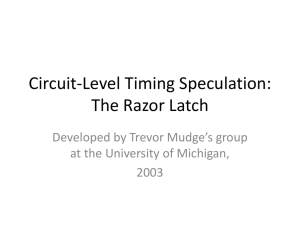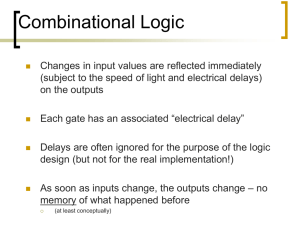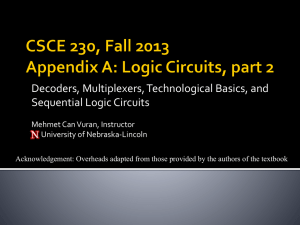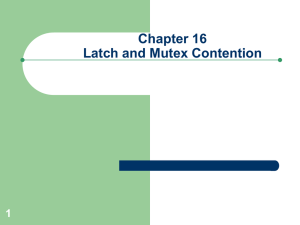25_Latches - Iowa State University
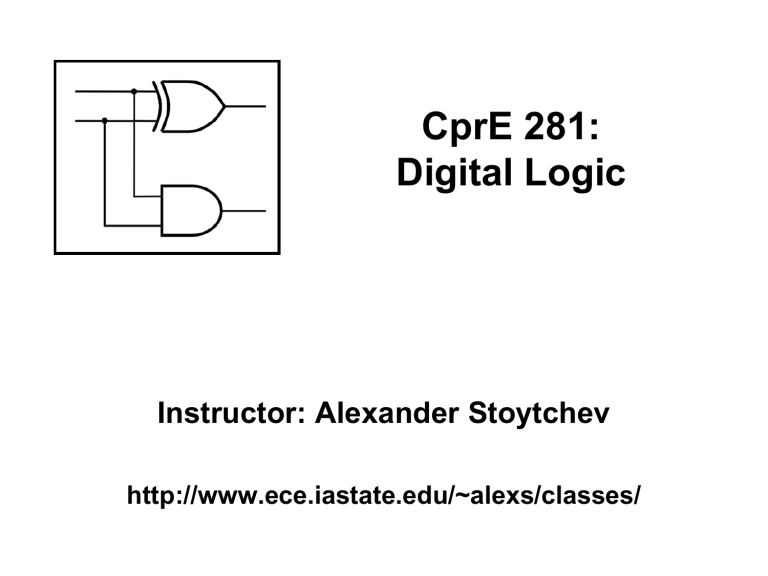
CprE 281:
Digital Logic
Instructor: Alexander Stoytchev http://www.ece.iastate.edu/~alexs/classes/
Latches
CprE 281: Digital Logic
Iowa State University, Ames, IA
Copyright © Alexander Stoytchev
Administrative Stuff
• HW 7 is due today
• Problem #3 will not be graded
Administrative Stuff
• Midterm Exam #2
• When: Monday October 28.
• Where: This classroom
• What: Chapters 1, 2, 3, 4 and 5.1-5.4
• The exam will be open book and open notes (you can bring up to 3 pages of handwritten notes).
Some Final Things from Chapter 4
A shifter circuit
[ Figure 4.50 from the textbook ]
A barrel shifter circuit
[ Figure 4.51 from the textbook ]
Chapter 5
Terminology
• Basic Latch – is a feedback connection of two NOR gates or two NAND gates, which can store one bit of information. It can be set using the S input and reset to
0 using the R input.
• Gated Latch – is a basic latch that includes input gating and a control input signal. The latch retains its existing state when the control input is equal to 0. Its state may be changed when the control signal is equal to 1.
[ Section 5.7 in the textbook ]
Terminology
• Two types of gated latches
(the control input is the clock):
• Gated SR Latch – uses the S and R inputs to set the latch to 1 or reset it to 0.
• Gated D Latch – uses the D input to force the latch into a state that has the same logic value as the D input.
[ Section 5.7 in the textbook ]
Terminology
• Flip-Flop – is a storage element that can have its output state changed only on the edge of the controlling clock signal.
• Positive-edge triggered – if the state changes when the clock signal goes from 0 to 1.
• Negative-edge triggered – if the state changes when the clock signal goes from 1 to 0.
[ Section 5.7 in the textbook ]
Terminology
The word latch is mainly used for storage elements, while clocked devices are described as flip-flops .
A latch is level-sensitive, whereas a flip-flop is edgesensitive. That is, when a latch is enabled it becomes transparent, while a flip flop's output only changes on a single type (positive going or negative going) of clock edge.
[http://en.wikipedia.org/wiki/Flip-flop_(electronics)]
Control of an alarm system
Sensor
Reset
Set
Memory element
Alarm
[ Figure 5.1 from the textbook ]
A simple memory element
A B
[ Figure 5.2 from the textbook ]
A simple memory element with NOT Gates x x x
A Strange Loop
[http://animalsiadmire.blogspot.com/2011/07/stupid-snake-eating-itself.html]
Building a NOT Gate with NAND
x x x x
0
1 x x
1
0 x x f
0 0 1
0 1 1
1 0 1
1 1 0 impossible combinations
Thus, the two truth tables are equal!
A simple memory element with NAND Gates x x x
Building a NOT Gate with NOR
x x x x
0
1 x x
1
0 x x f
0 0 1
0 1 0
1 0 0
1 1 0 impossible combinations
Thus, the two truth tables are equal!
A simple memory element with NOR Gates x x x
Basic Latch
A simple memory element with NOR Gates
A simple memory element with NOR Gates
A simple memory element with NOR Gates
Set Reset
A memory element with NOR gates
Reset
Set Q
[ Figure 5.3 from the textbook ]
Two Different Ways to Draw the Same Circuit
[ Figure 5.3 & 5.4 from the textbook ]
R
S
NOR Gate
Circuit and Truth Table
(a) Circuit
Q a
Q b
S R Q a
Q b
0 0
0 1
1 0
1 1
0/1 1/0 (no change)
0 1
1 0
0 0
(b) Truth table
[ Figure 5.4a,b from the textbook ]
NOR Gate Truth table x
1 x
2 f
0 0 1
0 1 0
1 0 0
1 1 0
Timing Diagram for the Basic Latch with NOR Gates
Q a
1
0
Q b
1
0
1
R
0
1
S
0
R
S
Q a
S R Q a
Q b
0 0
0 1
1 0
1 1
0/1 1/0 (no change)
0 1
1 0
0 0
Q b
(a) Circuit t
1 t
2 t
3 t
4 t
5 t
6 t
(b) Truth table
7 t
8 t
9 t
10
(c) Timing diagram
?
?
Time
[ Figure 5.4 from the textbook ]
An Even Simpler Example with Feedback
Let ’s try to analyze this circuit x f
Gated SR Latch
Motivation
• The basic latch changes its state when the input signals change
• It is hard to control when these input signals will change and thus it is hard to know when the latch may change its state.
• We want to have something like an Enable input
• In this case it is called the “Clock” input because it is desirable for the state changes to be synchronized
Circuit Diagram for the Gated SR Latch
[ Figure 5.5a from the textbook ]
Circuit Diagram for the Gated SR Latch
This is the “gate” of the gated latch
Circuit Diagram for the Gated SR Latch
Notice that these are complements of each other
Circuit Diagram and Characteristic Table for the Gated SR Latch
[ Figure 5.5a-b from the textbook ]
Circuit Diagram and Graphical Symbol for the Gated SR Latch
[ Figure 5.5a,c from the textbook ]
Timing Diagram for the Gated SR Latch
[ Figure 5.5c from the textbook ]
Gated SR latch with NAND gates
S
Clk
R
Q
Q
[ Figure 5.6 from the textbook ]
Gated SR latch with NAND gates
S
Clk
R
In this case the “gate” is constructed using NAND gates! Not AND gates.
Q
Q
Gated D Latch
Motivation
• Dealing with two inputs (S and R) could be messy.
For example, we may have to reset the latch before some operations in order to store a specific value but the reset may not be necessary depending on the current state of the latch.
• Why not just have one input and call it D.
• The D latch can be constructed using a simple modification of the SR latch.
Circuit Diagram for the Gated D Latch
[ Figure 5.7a from the textbook ]
Circuit Diagram and Characteristic Table for the Gated D Latch
Note that it is now impossible to have S=R=1.
[ Figure 5.7a,b from the textbook ]
Circuit Diagram and Characteristic Table for the Gated D Latch
When Clk=1 the output follows the D input.
When Clk=0 the output cannot be changed.
[ Figure 5.7a,b from the textbook ]
Circuit Diagram and Graphical Symbol for the Gated D Latch
[ Figure 5.7a,c from the textbook ]
Timing Diagram for the Gated D Latch
[ Figure 5.7d from the textbook ]
Setup and hold times t su t h
Clk
D
Q
Setup time (t su
) – the minimum time that the D signal must be stable prior to the the negative edge of the Clock signal
Hold time (t h
) – the minimum time that the D signal must remain stable after the the negative edge of the Clock signal
[ Figure 5.8 from the textbook ]
Some Practical Examples
Different Types of Switches http://www.industrial-electronics.com/Electricity-Refrigeration-Heating-Air-Conditioning_5b.html
Different Types of Switches
If you are building a circuit with latches you’ll need to use this type of switch.
http://www.industrial-electronics.com/Electricity-Refrigeration-Heating-Air-Conditioning_5b.html
Single Pole, Double Throw = SPDT
[http://electronicsclub.info/images/swabc.gif]
Single Pole, Double Throw = SPDT
[http://www.cubisteffects.com/images/MIY/Pt3_Throw.jpg]
Single-pole —single-throw manual switch http://www.industrial-electronics.com/Electricity-Refrigeration-Heating-Air-Conditioning_5b.html
Double-pole —single-throw manual switch http://www.industrial-electronics.com/Electricity-Refrigeration-Heating-Air-Conditioning_5b.html
The following examples came from this book
A Simple Circuit
[ Platt 2009 ]
Let ’s Take a Closer Look at This
[ Platt 2009 ]
A Similar Example with NAND Gates
[ Platt 2009 ]


